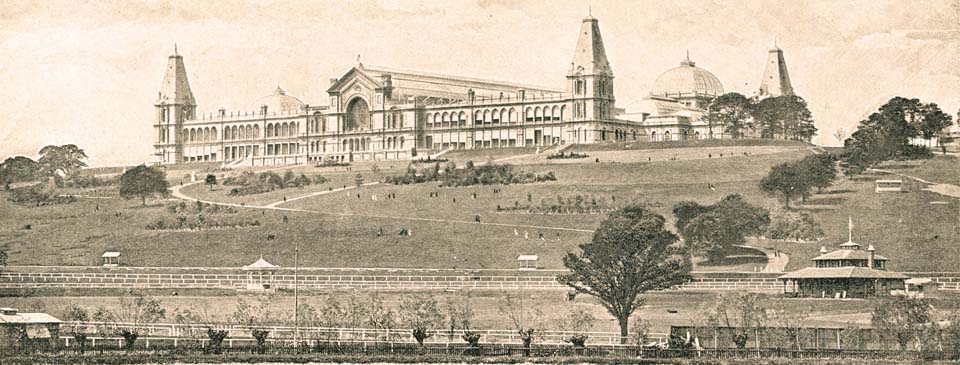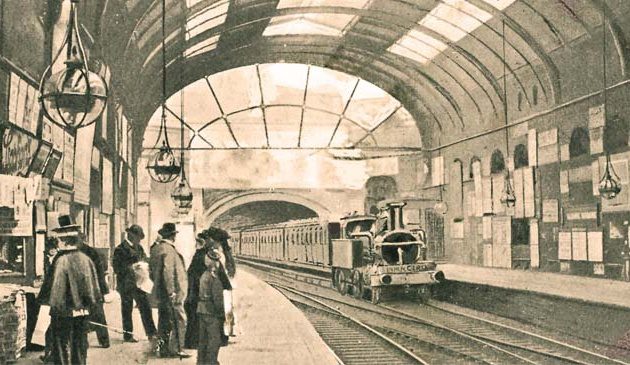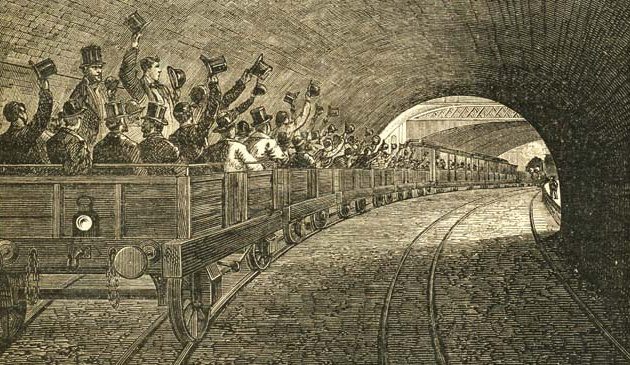Alexandra Palace and Park

Alexandra Palace opened to the public in May 1873 but was destroyed by fire just 14 days later. It was rebuilt in the following two years. In this picture we see the building and surrounding park as it was in the late 19th century and before the addition of its famous television mast.
To reach the new Palace from Wood Green station involved a strenuous uphill climb, which was not ideal if large numbers of visitors were to be attracted. A new branch railway was opened in 1867 from the Great Northern Railway at Finsbury Park to Highgate and Edgware. The GNR then created a line from Highgate station to the rear of the Palace, crossing a 17-arch viaduct. When the line to Alexandra Palace opened in 1873 visitors were able to travel by train directly from Kings Cross.
Alexandra Palace was finally completed and opened with a grand concert in May 1873, Queen Victoria’s birthday. The surrounding park, laid out by the landscape gardener Alexander McKenzie, covered 220 acres. It was an immediate success, with over 124,000 visitors in the first fortnight, mostly arriving by train.
However, after just 16 days, Alexandra Palace burned down, possibly caused by builders repairing a roof. Three Palace workers died and the fire left the building as a gutted ruin. It was a disaster for both the company and the railway but the company directors immediately agreed to rebuild.
The replacement was designed by John Johnson who had worked with Meeson on the original building and, as with the first, was constructed by the firm of Kelk & Lucas. It was of a significantly different design and larger than the original, occupying seven and a half acres. Its final cost was £417,128. It was opened by the Lord Mayor of London in May 1875. Two weeks later, on the Whit Monday holiday, 94,000 people visited.
The new Alexandra Palace included a large hall that seated 14,000 people. There was also a 3000-seat theatre, a 3500-seat concert hall, an Italian Garden courtyard with a large fountain, a conservatory filled with unusual plants, an exhibition and lecture room, and banqueting suites. Below the building were large kitchens. A major feature of the original and new buildings was the organ, both built by the Willis’s works at Camden Town. Henry Willis himself had only narrowly escaped from the fire. The new organ was the largest and most advanced in the country.
The main entrance to the Palace was then along an avenue on the north side that has since been covered with housing. At the four corners of the building were pointed towers that held water in case of further fires.
A wide range of entertainments were held at the Palace in its early days, including indoor and open-air concerts, organ recitals, theatrical drama, ballet, a circus, lectures and cookery demonstrations, flower shows, and exhibitions of paintings and sculpture. One room housed a permanent display of Lord Londesborough’s collection of arms and armour. Banqueting suits and ‘retiring rooms’ were available, as were telegraph and photographic services. In the park there were a funfair, regular fireworks, horse racing of different types, bicycle races, cricket, tennis, athletics, boxing, pigeon racing, an annual horse show, kite flying, balloon ascents, aerial displays, parachute jumping, various animal shows, and fetes. There were a series of ornamental lakes, boating, an open-air swimming pool, a Japanese village, and a Swiss chalet.
Alexandra Palace has rarely been financially successful. It was only at weekends and bank holidays that people came in great numbers, which was insufficient to cover the extremely high running costs. Just two years after it opened the Alexandra Palace Company sold the venture to the London Financial Association, which in turn leased it to successive managements, five of which went bankrupt. Various parts of the park to the north of the building were sold off for housing, including the triple lakes and the northern entrance. The Palace closed completely between 1889 and 1898.
Much of the surrounding districts of Muswell Hill, Hornsey, Wood Green and Tottenham were developed with terraced housing in the last two decades of the 19th century and Alexandra Palace Park increasingly became a valuable community asset. With the threat of further encroachment, a campaign began to secure the future of the building and grounds, led by Henry Burt of the Hornsey Urban District Council and Ralph Littler of Wood Green Urban District Council. That resulted in the Alexandra Palace and Park Act of 1900. The whole was acquired by a consortium of local authorities, including Middlesex County Council, at a cost of £165,000. There was a formal opening of the public park in May 1901 by the Duke of Bedford, Lord Lieutenant of Middlesex. Many of the entertainments of earlier years then resumed.
From the outbreak of the Great War in 1914 until March 1915 the Palace became a temporary transit camp for 38,000 Belgium refugees fleeing their homeland following the German invasion. Alexandra, by that time the Queen Mother, came to visit them at the place named after her. Thereafter it was used as an internment camp to imprison Germans living in Britain, who were employed in making improvements to the park. Alexandra Palace and park were reopened to the public at the beginning of the 1920s.
When the British Broadcasting Corporation were planning the introduction of a service of the recently invented television they sought a high place from which to transmit. They therefore rented the south-east tower of the Palace on which in 1935 they built a tall mast. The building below the mast was used as the studio. From there the world’s first regular high definition service began in November 1936.


